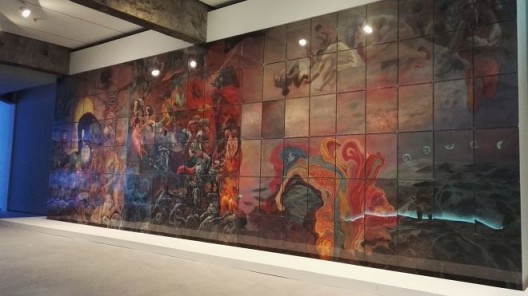“Rotation”: Xia Xiaowan solo exhibition
Beijing Minsheng Art Museum (Universal Creative Park, Chaoyang District, Beijing), October 31 – November 27, 2015
A “rotation” is nothing without observers, perhaps. Emphasizing the uniqueness and distinctive personality of Xia Xiaowan’s art, the curator Cui Cancan did not neglect to place the artist within the context of 1980s art movements. The curation inserted classic works by Wang Guangyi, Ding Fang and Sun Liang, hinting at historicity and the legitimacy of Xia’s “absence”. Yet the degree to which Xia Xiaowan is intoxicated with his own art world seems excessive in today’s context.
Looking back on Xia Xiaowan’s three decades of work, an obvious visual shift occurs when his images break free of the shackles of the two-dimensional and gain volume. Xia Xiaowan calls his three-dimensional works (those he made after 2003) “spatial paintings.” On glass plates he draws deconstructed images and then stacks them layer after layer, forming reconstructions. He brings this new approach to bear on “the metamorphosed human”—classical images he had originally created in the 1990s. Thanks to the transparency of the medium, these images are now “suspended” in the air, with an out-of-the-ordinary effect.
Placed in a prominent position in the gallery space, too, is a landscape series calling forth associations to “Early Spring”, the 2008 exhibition curated by Wu Hung. In reproducing Northern Song painter Guo Xi’s “Early Spring”, Xia Xiaowan converts into a visual experience the psychological experience of “feeling nature move inside of you, without leaving the house”. The illusion one experiences when looking at this painting is as if one could “travel inside of it.” Layered transparent landscape roller screens are hung at the end of the main hall much like a stage set. In contrast with other landscape works that might adopt sections of glass to configure such a scene, this feels somewhat more immersive.
Casting aside for the moment additional elements in his work, Xia Xiaowan’s signature images come from the fleshy works he created in the 1990s. Such subject matter and style obviously find their origins in surrealism (for instance Dali’s masterpiece “Soft Construction with Boiled Beans (Premonition of Civil War)”). Fidgety, restless expressive paintings attempt to expose the illusion of a culturally produced harmony. For Chinese artists of the 1990s, the resistance against “nature” in modernity in order to explore the essence of life was a general tendency. The “rotation” at that time took place within the system of the Chinese art world. Today’s “rotation”, on the other hand, is just Xia Xiaowan’s individual reflections. The sensory stimulation of the form itself is short-lived, and the relevance of the content is fading as we speak.
His supernatural series Portrait of the Other, representing deities and exhibited last year at Galerie Urs Meile in Beijing, has re-appeared here, and yet when rituals, religion, and mythology fade gradually back into the everyday, Xia Xiaowan’s spirit-conjurings lack resonance. The era of asking “Where do we come from?” “Who are we?” and “Where are we going?” is long past, and the sense of “mystery” has nowhere to hide. In turn, Xia Xiaowan’s current works have become facile signifiers. The largest painting at the venue, “Legend,” is comprised of 132 works in pastel, within which one can find motifs from each of the artist’s creative periods. The fragmented imagery sketches the story of Xia Xiaowan himself. Standing before the painting, it seems that all one can do is marvel at its enormous size.








